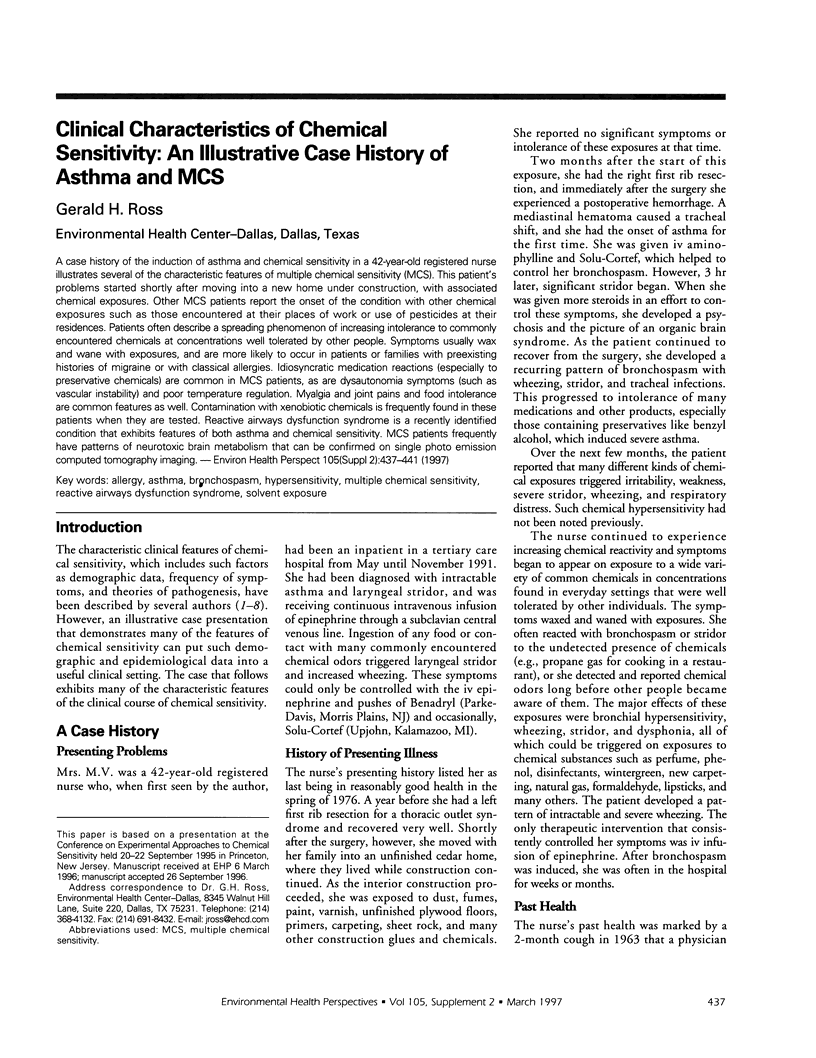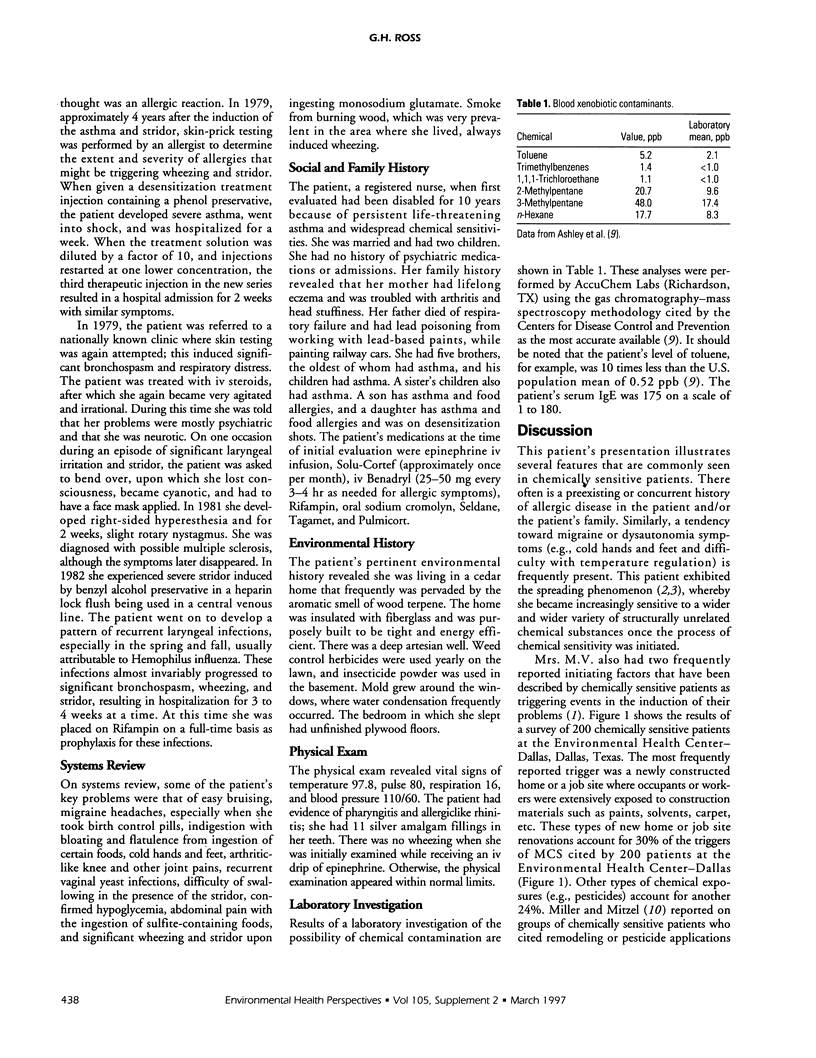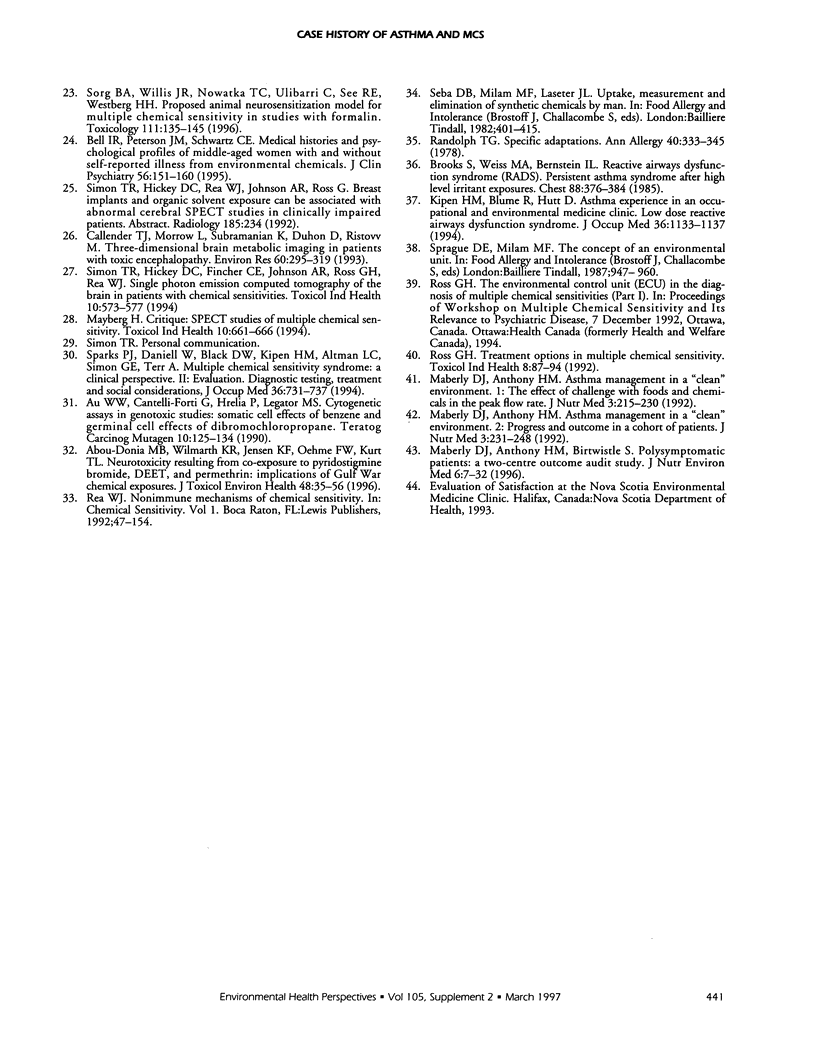Abstract
A case history of the induction of asthma and chemical sensitivity in a 42-year-old registered nurse illustrates several of the characteristic features of multiple chemical sensitivity (MCS). This patient's problems started shortly after moving into a new home under construction, with associated chemical exposures. Other MCS patients report the onset of the condition with other chemical exposures such as those encountered at their places of work or use of pesticides at their residences. Patients often describe a spreading phenomenon of increasing intolerance to commonly encountered chemicals at concentrations well tolerated by other people. Symptoms usually wax and wane with exposures, and are more likely to occur in patients or families with preexisting histories of migraine or with classical allergies. Idiosyncratic medication reactions (especially to preservative chemicals) are common in MCS patients, as are dysautonomia symptoms (such as vascular instability) and poor temperature regulation. Myalgia and joint pains and food intolerance are common features as well. Contamination with xenobiotic chemicals is frequently found in these patients when they are tested. Reactive airways dysfunction syndrome is a recently identified condition that exhibits features of both asthma and chemical sensitivity. MCS patients frequently have patterns of neurotoxic brain metabolism that can be confirmed on single photo emission computed tomography imaging.
Full text
PDF




Selected References
These references are in PubMed. This may not be the complete list of references from this article.
- Abou-Donia M. B., Wilmarth K. R., Jensen K. F., Oehme F. W., Kurt T. L. Neurotoxicity resulting from coexposure to pyridostigmine bromide, deet, and permethrin: implications of Gulf War chemical exposures. J Toxicol Environ Health. 1996 May;48(1):35–56. doi: 10.1080/009841096161456. [DOI] [PubMed] [Google Scholar]
- Ashley D. L., Bonin M. A., Cardinali F. L., McCraw J. M., Wooten J. V. Blood concentrations of volatile organic compounds in a nonoccupationally exposed US population and in groups with suspected exposure. Clin Chem. 1994 Jul;40(7 Pt 2):1401–1404. [PubMed] [Google Scholar]
- Au W. W., Cantelli-Forti G., Hrelia P., Legator M. S. Cytogenetic assays in genotoxic studies: somatic cell effects of benzene and germinal cell effects of dibromochloropropane. Teratog Carcinog Mutagen. 1990;10(2):125–134. doi: 10.1002/tcm.1770100208. [DOI] [PubMed] [Google Scholar]
- Bell I. R. Clinically relevant EEG studies and psychophysiological findings: possible neural mechanisms for multiple chemical sensitivity. Toxicology. 1996 Jul 17;111(1-3):101–117. doi: 10.1016/0300-483x(96)03395-1. [DOI] [PubMed] [Google Scholar]
- Bell I. R., Miller C. S., Schwartz G. E. An olfactory-limbic model of multiple chemical sensitivity syndrome: possible relationships to kindling and affective spectrum disorders. Biol Psychiatry. 1992 Aug 1;32(3):218–242. doi: 10.1016/0006-3223(92)90105-9. [DOI] [PubMed] [Google Scholar]
- Bell I. R., Peterson J. M., Schwartz G. E. Medical histories and psychological profiles of middle-aged women with and without self-reported illness from environmental chemicals. J Clin Psychiatry. 1995 Apr;56(4):151–160. [PubMed] [Google Scholar]
- Black D. W., Rathe A., Goldstein R. B. Environmental illness. A controlled study of 26 subjects with '20th century disease'. JAMA. 1990 Dec 26;264(24):3166–3170. doi: 10.1001/jama.264.24.3166. [DOI] [PubMed] [Google Scholar]
- Brodsky C. M. Psychological factors contributing to somatoform diseases attributed to the workplace. The case of intoxication. J Occup Med. 1983 Jun;25(6):459–464. doi: 10.1097/00043764-198306000-00011. [DOI] [PubMed] [Google Scholar]
- Brooks S. M., Weiss M. A., Bernstein I. L. Reactive airways dysfunction syndrome (RADS). Persistent asthma syndrome after high level irritant exposures. Chest. 1985 Sep;88(3):376–384. doi: 10.1378/chest.88.3.376. [DOI] [PubMed] [Google Scholar]
- Callender T. J., Morrow L., Subramanian K., Duhon D., Ristovv M. Three-dimensional brain metabolic imaging in patients with toxic encephalopathy. Environ Res. 1993 Feb;60(2):295–319. doi: 10.1006/enrs.1993.1039. [DOI] [PubMed] [Google Scholar]
- Davidoff A. L., Fogarty L. Psychogenic origins of multiple chemical sensitivities syndrome: a critical review of the research literature. Arch Environ Health. 1994 Sep-Oct;49(5):316–325. doi: 10.1080/00039896.1994.9954981. [DOI] [PubMed] [Google Scholar]
- Kipen H. M., Blume R., Hutt D. Asthma experience in an occupational and environmental medicine clinic. Low-dose reactive airways dysfunction syndrome. J Occup Med. 1994 Oct;36(10):1133–1137. doi: 10.1097/00043764-199410000-00017. [DOI] [PubMed] [Google Scholar]
- Mayberg H. Critique: SPECT studies of multiple chemical sensitivity. Toxicol Ind Health. 1994 Jul-Oct;10(4-5):661–666. [PubMed] [Google Scholar]
- Miller C. S., Mitzel H. C. Chemical sensitivity attributed to pesticide exposure versus remodeling. Arch Environ Health. 1995 Mar-Apr;50(2):119–129. doi: 10.1080/00039896.1995.9940889. [DOI] [PubMed] [Google Scholar]
- Overstreet D. H., Miller C. S., Janowsky D. S., Russell R. W. Potential animal model of multiple chemical sensitivity with cholinergic supersensitivity. Toxicology. 1996 Jul 17;111(1-3):119–134. doi: 10.1016/0300-483x(96)03370-7. [DOI] [PubMed] [Google Scholar]
- Randolph T. G. Specific adaptation. Ann Allergy. 1978 May;40(5):333–345. [PubMed] [Google Scholar]
- Rea W. J., Peters D. W., Smiley R. E., Edgar R., Greenberg M., Fenyves E. Recurrent environmentally triggered thrombophlebitis: a five-year follow-up. Ann Allergy. 1981 Nov;47(5 Pt 1):338–344. [PubMed] [Google Scholar]
- Ross G. H. History and clinical presentation of the chemically sensitive patient. Toxicol Ind Health. 1992 Jul-Aug;8(4):21–28. [PubMed] [Google Scholar]
- Ross G. H. Treatment options in multiple chemical sensitivity. Toxicol Ind Health. 1992 Jul-Aug;8(4):87–94. [PubMed] [Google Scholar]
- Rossi J., 3rd Sensitization induced by kindling and kindling-related phenomena as a model for multiple chemical sensitivity. Toxicology. 1996 Jul 17;111(1-3):87–100. doi: 10.1016/0300-483x(96)03394-x. [DOI] [PubMed] [Google Scholar]
- Simon G. E., Katon W. J., Sparks P. J. Allergic to life: psychological factors in environmental illness. Am J Psychiatry. 1990 Jul;147(7):901–906. doi: 10.1176/ajp.147.7.901. [DOI] [PubMed] [Google Scholar]
- Simon T. R., Hickey D. C., Fincher C. E., Johnson A. R., Ross G. H., Rea W. J. Single photon emission computed tomography of the brain in patients with chemical sensitivities. Toxicol Ind Health. 1994 Jul-Oct;10(4-5):573–577. [PubMed] [Google Scholar]
- Sorg B. A., Willis J. R., Nowatka T. C., Ulibarri C., See R. E., Westberg H. H. Proposed animal neurosensitization model for multiple chemical sensitivity in studies with formalin. Toxicology. 1996 Jul 17;111(1-3):135–145. doi: 10.1016/0300-483x(96)03371-9. [DOI] [PubMed] [Google Scholar]
- Sparks P. J., Daniell W., Black D. W., Kipen H. M., Altman L. C., Simon G. E., Terr A. I. Multiple chemical sensitivity syndrome: a clinical perspective. I. Case definition, theories of pathogenesis, and research needs. J Occup Med. 1994 Jul;36(7):718–730. [PubMed] [Google Scholar]
- Sparks P. J., Daniell W., Black D. W., Kipen H. M., Altman L. C., Simon G. E., Terr A. I. Multiple chemical sensitivity syndrome: a clinical perspective. II. Evaluation, diagnostic testing, treatment, and social considerations. J Occup Med. 1994 Jul;36(7):731–737. [PubMed] [Google Scholar]


